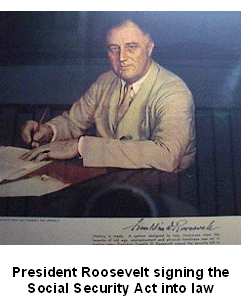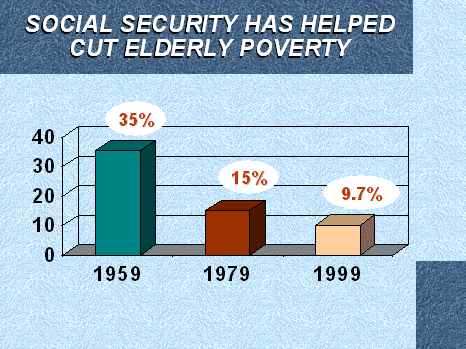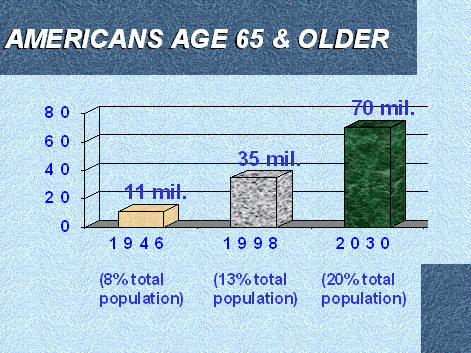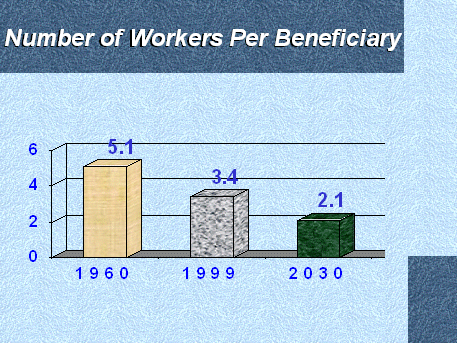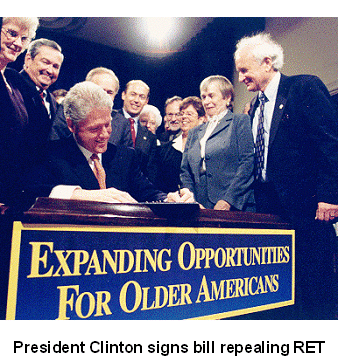History of SSA 1993-2000
uring the middle and late 1990s, polling data suggested some erosion in public confidence in Social Security. Younger people, particularly, had very low levels of confidence that benefits would “be there” for them when they retired. [1] A poll conducted by National Public Radio in 1999 indicated that there was still considerable confusion about the future of the Social Security system. [2] Because it is projected to have long-range financing problems, the Social Security program is high on the Nation’s agenda. The debate over long-term solvency remains a focus of intense public interest.
Fabric of America
ocial Security is part of the fabric of America and its importance to the nation cannot be overestimated. Approximately 153 million workers (96 percent of American workers and their families) are covered under Social Security. The program sends monthly benefits to more than 45 million beneficiaries. Social Security is our Nation’s greatest anti-poverty program. Without it, nearly half of all older Americans would be living in poverty today instead of 9.7 percent, the 1999 rate. Social Security benefits lifted roughly 15 million senior citizens out of poverty in 1999. For 24 million of the elderly, Social Security is a major source of income and for half of that group, it is their only source. [3]
In the last 40 years, Social Security has
helped cut the poverty rate among the elderly by 72%.
Demographic Challenges
hen the Board of Trustees issued their 2000 Annual Report on March 30, 2000, they projected that over the next 75 years, Social Security’s expenditures will exceed its income on average by 16 percent. The major factors placing a financial strain on the program are increasing longevity; lower birth rates; and fewer workers supporting more beneficiaries. In 1946, 11 million Americans were 65 or older, compared to 35 million in 2000. By 2030, this senior population is projected to grow to 70 million. As a result, the ratio of workers to retirees is projected to decline. Americans are living longer, healthier lives. The life expectancy at age 65 for men in 1940 was 11.9 years, compared to 15.8 years in 1999. In 1940, the life expectancy at age 65 for women was 13.4 years; in 1999 it was 19.1 years. By 2030, life expectancy at age 65 is projected to rise from the 1999 levels by another 1.7 years for men and 1.3 years for women.
Currently, there are about 35 million Americans age 65 and older; by 2030, there will be nearly twice that number. The demographic challenge facing Social Security is not just the number of years people are living; it is also a result of historical and projected birth rates. The period 1946-1964 was a time of high birth rates. Americans born during this period are referred to as the baby boom generation. This generation will begin to turn 65 in 2011. Following the baby boom period was one of much lower birth rates. In the future, birth rates are projected to remain at these lower levels. The number of workers for each beneficiary has declined and that trend will continue. In 1960, there were 5.1 workers per beneficiary. This ratio is projected to decrease to 2.1 workers per beneficiary by 2030, placing a strain on the pay-as-you-go system.
Financial Challenges
t is projected that the Social Security system will face a long-term deficit. In its 2000 Annual Report, the Board of Trustees estimates that the program’s expenditures will exceed its income over the next 75-year period. The Old Age, Survivors, and Disability Insurance (OASDI) Trust Funds will incur an actuarial deficit of 1.89 percent of taxable payroll. [4] Based on intermediate assumptions, the OASDI Trust Funds are projected to begin paying out more in benefits than they collect in taxes in 2015. Total income (tax revenue plus interest income) will exceed outgo until 2025. The Trust Funds are expected to decline until exhaustion in 2037, when annual tax income will be able to pay for only about 72 percent of benefits. Annually, the Board of Trustees releases a report on the financial condition of the OASDI Trust Funds. The following chart shows the history of the Trustees’ projections for each year of the Clinton Administration when the Trust Funds will become insolvent.
Social Security Trustees’ Reports
By using the intermediate assumptions, it is estimated that the Social Security system will be insolvent in 2037. However, this projected insolvency of the Trust Funds is not unprecedented. In the 1970s, the Social Security Board of Trustees predicted short-term and long-term financial problems for the system. This situation was created by a variety of economic and demographic trends, such as higher than expected inflation, lower fertility rate, and the relationship between wage and price growth. Congress addressed these issues with the passage of the 1977 Amendments. Major provisions included: increasing the tax rate; increasing the earnings base; lowering the age at which the earnings test no longer applied; and reconfiguring the benefit formula. In the early 1980s, the Social Security program faced another serious financing crisis. A blue-ribbon panel, known as the Greenspan Commission, was appointed to study the financing issues and make recommendations for legislative changes. The final bill, signed into law in 1983, made numerous changes to the Social Security program including: taxing Social Security benefits; covering federal employees; raising the retirement age, starting in 2000; and increasing the reserves in the Trust Funds. With the l983 Amendments, financing problems faced by Social Security in the late 1970s and early 1980s were temporarily resolved, but the long-range financing challenge reappeared a few years later.
Advisory Council on Social Security
s required by law on March 23, 1994, the Secretary of Health and Human Services, Donna E. Shalala, established the 1994-1996 Advisory Council on Social Security. Secretary Shalala and Commissioner Shirley S. Chater asked the Advisory Council to focus specifically on the long-term fiscal imbalance of the OASDI program. The Advisory Council used the intermediate assumptions of the 1995 report of the Board of Trustees to examine the benefit structure in the OASDI program from various distributional perspectives and to recommend revisions as appropriate. While the Advisory Council expected to release their report in 1995, they finally released it in January 1997. Although the Advisory Council agreed on the overall concerns about the program, they could not reach consensus on a single approach for dealing with Social Security’s financial difficulties. The Council members were deeply divided on recommending an approach to address the long-range financing problem facing Social Security. Various Council members developed three different solvency plans; no single plan was supported by a majority of the 13 members. As the Council itself indicated with regard to the different proposals, “…each involves a very different vision for the future evolution of the U.S. retirement system.” The three different plans were: 1. Maintenance of Benefits (MB) – Includes keeping the program’s overall benefit structure the same; eventually increasing the payroll tax and minor benefit cuts; and investing part of the Trust Funds in the stock market. 2. Publicly-Held Individual Accounts (IA) – Includes cuts in benefits; employees contributing 1.6 percent of pay to individual savings accounts, in addition to the current.12.4 percent OASDI tax rate. 3. Privately-Held Individual Accounts (PSA) – Includes replacing Social Security with a two tier system consisting of a flat retirement benefit (tied to the number of years of work) and an individually owned retirement account funded by a 5 percentage point contribution from the current OASDI tax rate. Congressional Interest and Solvency Proposals
hile a few Social Security reform proposals had been offered prior to the release of the Advisory Council’s report, the release of this report acted as a catalyst for increased public and congressional interest in how best to address the long-range financing issues of the Social Security program. Over the period 1993-2000, Congress held 46 hearings on Social Security solvency or closely related issues. The topics of the hearings ranged from the overall status of the trust funds, to specific solvency plans, to specific features of some plans—e.g., raising the retirement age. Most of these congressional hearings occurred after the Advisory Council submitted their report. Of these 46 hearings, an SSA witness testified at 27 of them, 18 of which the Commissioner of Social Security provided testimony. In the 103rd-105th Congresses (1993-1998), 21 plans were offered by Members of Congress to provide reforms to deal with the long-range financing challenge facing Social Security, and in the 106th Congress (1999-2000), there were 23 such plans. In general, the solvency bills were sponsored by relatively few Members of Congress and often had only a small number of or no co-sponsors. In some cases, the same Member of Congress introduced several bills that were variations on a theme. No single bill or specific plan gained significant support in the Congress. In addition to Congress sponsored plans, various commissions proposed their own solutions. For example, President Clinton established the 1994 Bipartisan Commission on Entitlement and Tax Reform [5] to examine the impact of entitlement programs on the Nation’s future and to recommend reforms. The Center for Strategic and International Studies developed the 1998 National Commission on Retirement Policy to examine the fiscal challenges posed by the retirement of the Baby Boom population. “Think-tanks” and other public policy organizations as well as prominent individuals with long-standing interest in Social Security were also active in developing and suggesting their own plans. Proposals for reforming Social Security ranged from maintaining the current structure to changing the investment strategy of the Trust Funds, to dismantling Social Security altogether and privatizing retirement savings. [6] Proposals, designed to improve long-range solvency, achieve this goal through reductions in benefits, increases in revenues, or some combination of both. Options that policymakers have been considering to reduce benefits include cutting the annual cost-of-living adjustment (COLA), changing the benefit formula, making across-the-board cuts, and increasing the normal retirement age. Options to increase trust fund revenue include raising payroll taxes; transferring revenues from the general fund of the Treasury to the Trust Funds; covering newly hired state and local employees in the system, and increasing the amount of earnings subject to the payroll tax. [7] Almost all legislative proposals advanced to restore long-range solvency would make use of the nation’s financial markets to improve the rate of return under the system. One group of proposals would alter the Social Security trust fund’s investment policies to allow the funds to include equity investments. This change would be consistent with the investment practices of state pension funds and is designed to increase the return to the trust funds so that smaller reductions in benefits or smaller increases in revenue would be needed. Some proposals include provisions that would use some of the Federal budget surplus to make general revenue transfers to support Social Security. Other proposals would permit or mandate the creation of personal savings accounts—either as a substitute for Social Security benefits or as a supplement to them. These accounts are generally financed either by a redirection of a portion of the current Social Security payroll tax or by funds from general revenues of the government. Because redirecting a portion of payroll taxes to fund individual accounts would have a negative effect on solvency, these plans include elements that would reduce benefits. In some cases, the plan calls for the reduction or offset of the Social Security benefit based on the growth, or hypothetical growth, in the person’s individual account. Another proposal was unique in that it would guarantee the current benefit level, fund individual accounts through general revenues (rather than redirecting a portion of the payroll tax), and then offset the Social Security benefit in most cases by 100 percent of the amount accumulated by the individual account.
The President’s Social Security Proposals
n September 10, 1997, during his confirmation hearing as Social Security Commissioner Designee, Kenneth Apfel stated: “In all candor, Mr. Chairman, critical discussions about the future of the Social Security program need to take place not only in committee hearing rooms on the Hill, but also in family living rooms all across America. As Commissioner, one of my roles will be to help Americans understand Social Security today, so that they will be prepared to make the tough choices to ensure the program will be there for them tomorrow.” Four months later, President Clinton directly addressed the long-term financing problems that were facing the Social Security program in his 1998 State of the Union address and laid out a process to achieve meaningful reform. At the time of his State of the Union address, surpluses ($1 trillion over the next 10 years) were projected in the unified budget, but, he said, the surpluses shouldn’t be used until we “Save Social Security First.” He said we must educate Americans so that they understand the Social Security program and the issues facing it. President Clinton invited all Americans to join in the discussion. He called for a series of non-partisan, town hall forums throughout the country to engage the citizenry in an informed public debate. On February 9, 1998, he delivered a major address on Social Security at Georgetown University in Washington, D.C. as the unofficial launch of the year-long process of discussing the future of Social Security. The Agency played a prominent role as 1998 became a year of intensive activity aimed at expanding the discussion of the Social Security program. Commissioner Apfel urged dozens of organizations, including advocacy groups for minorities, youth, and senior citizens; public policy and grass roots groups; trade associations; and business and labor organizations to engage in the dialogue. Social Security provided informational materials and analyses to help promote the discussions. At the beginning of this initiative, Commissioner Apfel indicated the importance of these discussions when he made a speech to the National Academy of Social Insurance at the National Press Club on January 30, 1998, just three days after the President’s State of the Union address. He said: “In the coming weeks and months, we need to educate the American public about the basics of this complex, financial program. We need to explain its importance, and we need to make the program real to as many Americans as possible.” In addition to these agency activities, Commissioner Apfel participated in regular White House meetings with the President’s Senior Economic team to explore policy options and to assist the President in developing his Social Security reform proposal. This group met regularly with the President to discuss how best to achieve meaningful Social Security reform. Those meetings continued throughout the remainder of the President’s second term in office.
At the request
of the President, the Concord Coalition and the American Association
of Retired Persons co-sponsored The Great Social Security Debate,
a series of national discussions about the future of Social Security
that President Clinton had called for in his State of the Union
address. On April 7, 1998, President Clinton participated
in the first of the national forums. It was held on the campus
of Penn Valley Community College in Kansas City, Missouri.
The second forum took place in Providence, Rhode Island on July
1, 1998, and featured In his 1999 State of the Union address, the President laid out his proposal to “Save Social Security First.” He proposed transferring 62 percent of the unified budget surpluses ($2.8 trillion) to Social Security over the next 15 years; saving 15 percent of the surpluses to shore up Medicare; and investing 12 percent of the surpluses into new Universal Savings Accounts. The remaining 11 percent was for defense and other domestic priorities. This would extend solvency an additional 23 years, from 2032 to 2055. At this time, budget projections began to show that the federal government would accumulate substantial budget surpluses in addition to those produced by Social Security. Republican Leadership responded to the President’s proposal to transfer 62 percent of the unified budget surplus to Social Security by pledging to “lock away” the entire Social Security surplus. Much of 1999 turned into a debate over protecting the Social Security surplus, rather than a debate over how to achieve long-term solvency for Social Security. In his 1999 State of the Union address, President Clinton also expressed his concern about relatively high poverty rates among older women stating “We should reduce poverty among elderly women, who are nearly twice as likely to be poor as our other seniors….” Throughout 1999, SSA analyzed numerous proposals to enhance Social Security benefits in ways that would reduce high poverty rates among older women, particularly widows, relative to the overall elderly population and provide improved economic protection for an especially vulnerable segment of society. In his 2000 State of the Union message, President Clinton modified his proposal in an effort to achieve bipartisan consensus. He called for locking away the entire Social Security surplus; paying down the national debt; and dedicating the interest savings to Social Security, which would extend solvency from 2037 to 2054. In addition, the President recommended investing a small share of the Trust Funds in equities to further extend the life of the Trust Funds. He called on Congress to work with him on a bipartisan basis to make the additional changes necessary to strengthen the Social Security program and put the program in long-term actual balance. Throughout 2000, the Administration and Congress attempted to try and advance the debate, despite the looming presidential campaign. The President continued to urge Congress to address the generational challenges facing America in this time of prosperity. Commissioner Apfel continued to travel throughout the country urging that America address these challenges sooner than later. Unfortunately, as President Clinton’s term of office came to a close, it became evident that meaningful Social Security reform would not be achieved during this session of Congress.
The Agency’s Education, Policy, and Research Efforts
hroughout the President’s second term, SSA worked to ensure that the public had the information it needed to understand the essentials of the program, so they could participate in the discussion of how best to strengthen Social Security for the future. When the President called for a major public discussion on the long-range future of the Social Security program in 1998, the Agency was well positioned to meet its responsibility of advancing public education. Social Security employees had a central role to play in these discussions, not by taking sides, but by educating. In order for SSA to more effectively serve the public, there was a big push behind expanding the capacity of our workforce to engage the public. In 1998, SSA established the “Employees as Ambassadors Program” and trained all 65,000 employees—many whom have become specialists—to answer the tough questions about Social Security. Supporting this effort was an aggressive, proactive public education outreach campaign during the two-year period of 1998 and 1999, employees participated in more than 10,000 events and media opportunities on issues affecting Social Security’s future. These events included community seminars, co-sponsored by organizations such as the Junior Chamber of Commerce and Americans Discuss Social Security, and Congressional forums, newspaper editorial boards, and Internet discussions. SSA developed special public information materials to support the national dialogue on long-range financing and published a new booklet entitled The Future of Social Security that outlined important program and financing issues. Well over one million copies of the booklet were distributed. SSA developed several short background papers about the workings of current Social Security programs for the forums and discussion groups on Social Security solvency issues. The material received more general distribution through SSA’s website and elsewhere. The papers included pieces describing how Social Security benefits help women, minorities, and low-wage workers. Another described the low administrative costs of the current program. A series of questions and answers were developed to provide financial and statistical information on solvency issues. They directed website users to selected tables on the trust funds, the financing for Social Security and Medicare, and the dates of currently projected long-range financing shortfalls in the OASI, DI and HI programs. Estimates of the number of workers insured under Social Security and the approximate ratio of workers to beneficiaries were also presented in this way. Fact sheets and other materials were prepared for distribution and discussion at several symposiums such as the October 1998 “White House Round Table on Women and Social Security” and the “First Lady’s Social Security and Women” event held on January 23, 1999. In addition, SSA worked internally and externally developing models and simulations that determined the impact of making major changes to the Social Security system. These included models such as Historical Cohorts, Microsimulation, [8] Modeling Income in the Near Term, and CORSIM. These models dealt with the effects of changes to the Social Security program on distributional impact, economically vulnerable beneficiaries, and long-term cost analyses. SSA continues to prepare materials on all fiscal effects of various proposals to change the Social Security program. Although the public debate on long-term solvency of the Social Security system became a central issue in the 2000 Presidential Campaign, national political leaders could not agree on legislation to strengthen the program. In an interview with Planet Gov.Com on October 12, 2000, Commissioner Apfel said: “My one regret is that we’re not sitting here today saying that we have taken the financial steps that were necessary to assure that we can look our grandchildren in the eyes and say we’ve got the right financing system in place, that their benefits will be as strong for them as they were for our grandparents.” He further stated in an interview with the Boston Globe on November 5, 2000, “I was hoping that by now we would see legislation designed to ensure that Social Security would be strong through the 21st Century. Obviously, we haven’t made it to the finish line on that one.” As indicated, while no consensus on what to do was reached, many agreed that the sooner an agreement is reached the better.
Repeal of the Retirement Earnings Test (RET)
nother significant change in Social Security during the Clinton Administration was the repeal of the Retirement Earnings Test (RET). Originally, Social Security was designed as a social insurance program under which workers and their dependents were to be insured against the loss of earnings as a result of retirement, disability, or death of the worker. Benefits were intended to partially replace the earnings that are actually lost due to these events. In that context, the RET was designed as an objective measure of the earnings amount lost due to retirement. The Social Security program always had a RET. However, the “all-or-nothing” test in the original 1935 Social Security Act was modified numerous times to allow retirees to supplement benefits with earnings up to a specified level. Prior to the repeal in 2000, the first change to the RET during the Clinton Administration occurred in 1996. With the strong support from President Clinton and the Congress, the annual exempted amounts for beneficiaries aged 65 to 69 were legislated to rise annually until reaching $30,000 in 2002. This increase gave many older Americans the opportunity to supplement their Social Security benefits while remaining productive members of the workforce. Prior to the repeal of the RET, benefits were reduced $1 for every $3 of earnings above the annual exempt amount for beneficiaries age 65-69. Benefits were reduced $1 for every $2 of earnings above the annual exempt amount for beneficiaries below age 65. Unearned income, such as interest income, dividend payments, private pensions and the like, were not counted for purposes of the RET. In addition, workers were exempt from the test when they reached age 70. For a worker below age 70, his or her earnings above the exempt amount affected not only his or her own benefits, but also the benefits of family members receiving benefits on the worker’s earnings record. However, if a dependent or survivor beneficiary has earnings above the exempt amount, those earnings can affect only that individual’s payments. Delayed retirement credits (DRC) are provided to compensate workers age 65-69 whose benefits are withheld under the RET. The DRC increases the worker’s retirement benefit for each month after the full benefit retirement age (now age 65 but scheduled to rise to 67 by 2022) that the worker delays filing for benefits or benefits are fully withheld. The DRC is currently six percent per year for workers age 65 in 2000. The DRC percentage will increase 0.5 percentage point every two years until it reaches 8 percent per year for workers reaching full retirement age in 2008 and later. When the DRC is 8 percent per year, benefits lost due to delayed retirement generally will be offset in an actuarially fair manner by the increase in benefits resulting from DRCs. In early 2000, both the Congress and the President signaled a willingness to repeal the Retirement Earnings Test for those above the normal retirement age. Commissioner Apfel testified before the House Ways and Means Subcommittee on Social Security on this issue on February 15, 2000. Congressional action was swift. The legislation quickly went to the full House where it was passed 422-0 on March 1, 2000 and 100-0 on March 22, 2000 in the Senate. On April 7, 2000, President Clinton signed Public Law 106-182, The Senior Citizens' Freedom to Work Act of 2000. This Act eliminated the RET and the 45-hour foreign work test in and after the month in which a person attains full retirement age, retroactive to January 1, 2000. It also permitted beneficiaries to decline current monthly benefits so that they can earn DRCs. This legislation was estimated to have a negligible effect on the long range financing of Social Security. Earnings at or after the full retirement age no longer count towards the RET. Beginning in 2000, earnings between January of the year an individual reaches Normal Retirement Age (NRA) and the month before the month of attainment of NRA are counted toward the $1 for $3 RET. For 2000, the excess over $17,000 is counted. For 2001, the excess over $25,000 is counted and for 2002, the excess over $30,000 is counted. Thereafter, the threshold is indexed to the growth in average wages. Beneficiaries would continue to be subject to the lower $1 for $2 test for earnings prior to January of the year of attainment of the NRA. As a result of this legislation, about 800,000 beneficiaries age 65-69 and 150,000 auxiliary beneficiaries, who previously lost some or all of their benefits under the test, now receive full benefits. In May 2000, about 400,000 beneficiaries in this group were reinstated and received retroactive payments averaging $3,500 per person for benefits due since January. SSA paid a total of $1.5 billion in refunds just three weeks after the legislation was signed into law. Beginning in June 2000, SSA automatically reinstated working beneficiaries as they attained full retirement age. Between May 2000 and October 2000, SSA sent a series of one-time “Good News” notices informing over 9 million affected working and non-working beneficiaries of the change in the RET and the new option to earn DRCs.
Conclusion
he Social Security program has become the most successful and most popular domestic program in the nation’s history. It has been providing economic security for workers and their families for 65 years and is America’s greatest anti-poverty program. Social Security has made an enormous difference in the lives of older Americans, as more than nine in ten of them receive retirement benefits each month. However, the 2000 Board of Trustees Report estimates that the OASDI Trust Funds will be exhausted in 2037. President Clinton, Members of Congress, different commissions and organizations, and prominent individuals with a long-standing interest in Social Security all sponsored solvency plans. The Agency played a key role in ensuring that the public had the information it needed to understand the essentials of the program, so they could participate in the discussion of how best to strengthen Social Security for the future. Social Security provided informational materials and analyses to help promote the discussions. [9] While no consensus on what to do was reached, the need to resolve the long-range financing issue has been made very clear. It will be up to future Administrations and Congresses to address this critical challenge of the aging of America.
[1] American Council of Life Insurance. The Polls-Poll Trends: Social Security, An Update. Public Opinion Quarterly, Fall 1995, pgs. 424-425. [2] National Public Radio. 1999, “NPR, the Kaiser Family Foundation, and Harvard University’s Kennedy School of Government’s Poll on Social Security.” [4] Based on 2000 Trustees Report, intermediate assumptions. The actuarial balance is the most commonly used measure of long range solvency of the OASDI program. This measure indicates the size of the difference between expected financing and cost for the program over a 75 year period. The actuarial balance is expressed as a percentage of taxable payroll over the 75 years. [6] Daly, Mary C., Economist, Federal Reserve Bank of San Francisco, Economic Letter, Number 99-20, June 25, 1999. [9] For SSA program statistics during the Clinton Administration, see SSA’s Annual Statistics Supplement.
Exhibit 1Examples
of Options from the
|
|||||||||||||||||||||||||||||||||||||||||||||||||||||||||||||||||||||||||||||||||||||||||||||||||||||||||||||||||||||
Options |
Savings as a % of Taxable Payroll |
% of Social Security Deficit Resolved |
Lower Benefits |
||
| Reduce the COLA by 0.5 percentage point below CPI, beginning 12/2001 |
0.74% |
39% |
| Reduce the COLA by 1.0 percentage point below CPI, beginning 12/2001 |
1.44% |
76% |
| Increase the number of years used to calculate benefits for retirees and survivors from 35 to 38, phased in 2002-2006 |
0.25% |
13% |
| Increase the number of years used to calculate benefits for retirees and survivors from 35 to 40, phased in 2002-2010 |
0.40% |
21% |
| Reduce benefits across the board by 3 percent for new eligibles, beginning in 2001 |
0.36% |
19% |
| Reduce benefits across the board by 5% for new eligibles, beginning in 2001 |
0.60% |
32% |
| Speed up present law phase in of increase in the normal retirement age to 67 by 2011 |
0.13% |
7% |
| Increase the normal retirement age to 67 by 2011; then index (normal retirement age=69 by 2059 and continues to rise) |
0.52% |
27% |
Options |
Savings as a % of Taxable Payroll |
% of Social Security Deficit Resolved |
Increase Revenues |
||
|
1.96% |
104% |
|
| Cover all newly-hired State and local government employees, beginning in 2002 |
0.21% |
11% |
| Make 90% of earnings subject to payroll tax ($145,800 maximum in 2003), with increase phased in 2001-2003 |
0.64% |
34% |
Other Options |
||
| Invest 40% of Trust Funds in stocks over 15 years, phased in beginning in 2001 |
1.02% |
54% |
| Transfer money from Federal budget surplus (general revenue) to offset the OASDI Trust Fund deficit | ||
| Use a portion of the payroll tax (e.g., 2% or 5%) to provide mandatory individual accounts. | Impact would depend on the portion of payroll taxes carved out. | |

